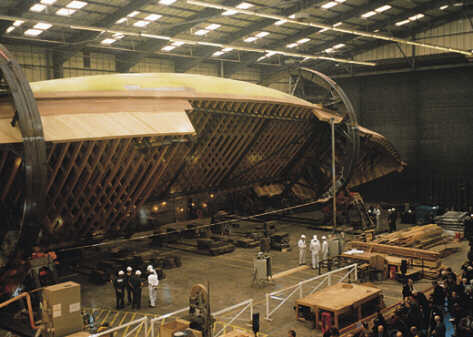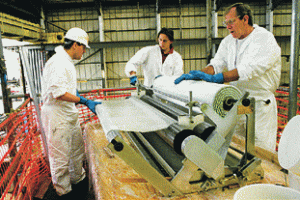- Boat Building & Repair
- Boat Construction
- Weird & Wonderful
- Yacht & Large Vessel Construction
- EpoxyWorks #13


By Wessex Resins & Adhesives Ltd., UK
To a fanfare of music, lights and fireworks HRH Prince Andrew pressed the button and the 400 invited guests watched anxiously as the largest wooden ship under construction in the world began to move.

The hull planking consists of five layers of timber; four of Siberian larch, one of Khaya. Sheathing the hull was a large task, and consisted of a lay-up of one layer of 300 g/m2 (8.8 oz/yd2) plain woven fabric, three layers of quadraxial 1034 g/m2 (30.5 oz/yd2), followed by another layer of 300 g/m2. On the keel, all five layers were laminated at one time.
On the hull, the first three plies were initially applied together then covered with a layer of peel ply; the final two layers were laminated the next day. To maximize the working time available, WEST SYSTEM® 105 Resin was used with the 209 Extra Slow Hardener throughout the laminating period. The longer gel time of the 105/209 system proved beneficial at working temperatures between 18°C and 23°C (64°F and 73°F). The total operation was extremely successful.
The hull was completely sheathed within four weeks, starting on the 18th of September, and finishing on the 15th of October. An average of eight laminators were employed to cover the 900m2 (9,680 ft2) hull with five applications of glass fabric.
Two 892-150 Impregnators — the 150cm (60″) wide units — were used throughout the sheathing, without which the task would have been impossible to complete in such a short time.
During the sheathing, we provided technical support: David Johnson, Ian Oliver, and Peter White all spent time helping out. David spent almost fourteen days at the Jubilee yard and is now a qualified “laminator extraordinaire!”
The giant steel rings seen in the photographs are normally used on submarines, and weighed 60 metric tonnes (66.12 short tons), which, with the hull, ensured that the total structure to be rolled was well in excess of 225 tonnes (248 tons). It is the first time that a tall ship has been turned this way.
Fifteen minutes after Prince Andrew pushed the button to begin the roll-over, the 65 meter ship had turned 45°. With regular inspections taking place throughout the roll-over, the full turning took about two hours to complete.